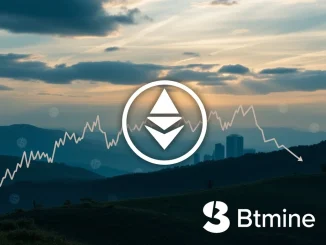
Big news shaking up the crypto and traditional finance worlds! Japanese financial giant SBI Holdings, along with its subsidiary SBI Shinsei Bank, has just made a significant move. They’ve collectively invested $50 million in Circle, the company behind the popular USDC stablecoin. This investment comes right after Circle’s initial public offering (IPO) and highlights a growing connection between established finance and the digital asset space.
What Does the $50M SBI Circle Investment Mean?
The $50 million commitment is split equally, with both SBI Holdings and SBI Shinsei Bank contributing $25 million each. This isn’t just a random investment; it follows a strategic joint venture the two companies formed with Circle earlier this year. That partnership specifically aims to promote the use and circulation of the USDC stablecoin within Japan.
Here’s a quick breakdown of the investment:
- Total Investment: $50 million
- Investors: SBI Holdings ($25M) and SBI Shinsei Bank ($25M)
- Recipient: Circle (USDC Issuer)
- Timing: Follows Circle’s IPO
- Context: Builds on an existing joint venture for USDC adoption in Japan
How Does the Circle IPO Play a Role?
The investment coming after the Circle IPO is noteworthy. An IPO typically provides a company with significant capital and increases its public profile. For SBI to invest post-IPO suggests confidence in Circle’s valuation, business model, and future prospects as a publicly traded entity. It could also indicate that the IPO process itself validated Circle in the eyes of traditional financial institutions like SBI Holdings.
Investing in a company that has successfully navigated the path to becoming a public company might be perceived as a lower-risk entry point for traditional finance players looking to deepen their ties with the crypto sector. It provides a level of transparency and regulatory scrutiny not always present in private crypto firms.
Boosting USDC Adoption in Japan: The Joint Venture
The core purpose behind this financial backing is directly tied to the previously announced joint venture. The goal is clear: accelerate USDC adoption Japan. Japan has specific regulations regarding stablecoins, and the partnership between SBI and Circle is designed to navigate this landscape and facilitate the compliant use of USDC.
What could this mean for Japan?
- Increased Accessibility: Making it easier for Japanese businesses and consumers to use USDC for payments and other transactions.
- Regulatory Clarity: Working within Japan’s regulatory framework to ensure USDC operates legally and safely.
- New Use Cases: Exploring how USDC can be integrated into existing financial services and potentially create new ones within Japan.
- Global Connectivity: Connecting the Japanese financial system more directly with the global digital dollar ecosystem represented by USDC.
Why is This Important for SBI Holdings?
SBI Holdings is a major player in the Japanese financial services industry, with diverse interests ranging from banking and securities to asset management and venture capital. Their continued push into the digital asset space, including this significant investment in Circle, signals a strategic pivot towards the future of finance. For SBI, this move is likely about:
- Staying competitive in an evolving financial landscape.
- Capitalizing on the growth potential of stablecoins and digital payments.
- Leveraging their existing financial infrastructure to integrate new technologies.
- Positioning themselves as a leader in digital finance within Japan and potentially Asia.
This investment isn’t just about stablecoins; it’s about SBI solidifying its position at the intersection of traditional finance and innovative digital technologies.
Implications for Cryptocurrency Investment
This development has broader implications for the entire Cryptocurrency investment landscape. When large, established financial institutions like SBI Holdings make substantial investments in crypto-native companies like Circle, it lends credibility to the sector as a whole. It suggests that digital assets, particularly regulated stablecoins, are increasingly being viewed as legitimate financial instruments with real-world applications.
This trend could encourage other traditional finance firms to explore similar opportunities, potentially leading to more capital flowing into the crypto market. It also highlights the growing importance of stablecoins as a bridge between fiat and decentralized finance.
Conclusion
The $50 million investment by SBI Holdings and SBI Shinsei Bank in Circle is a major development. It underscores the deepening relationship between traditional finance and the crypto world, particularly in the realm of regulated stablecoins like USDC. Coming after the Circle IPO and building on a joint venture focused on USDC adoption in Japan, this move is strategic for all parties involved. It could pave the way for increased stablecoin usage in a major economy and signals continued confidence from institutional players in the future of digital finance. Keep an eye on how this partnership unfolds and its impact on the Japanese market and the broader crypto ecosystem.



